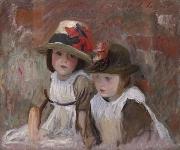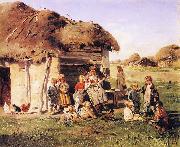
|
John Singer Sargent
|
|||
|
|
|||
| 1856-1925 John Singer Sargent Locations John Singer Sargent (January 12, 1856 ?C April 14, 1925) was the most successful portrait painter of his era. During his career, he created roughly 900 oil paintings and more than 2,000 watercolors, as well as countless sketches and charcoal drawings. His oeuvre documents worldwide travel, from Venice to the Tyrol, Corfu, the Middle East, Montana, Maine, and Florida. Before Sargent??s birth, his father FitzWilliam was an eye surgeon at the Wills Hospital in Philadelphia. After his older sister died at the age of two, his mother Mary (n??e Singer) suffered a mental collapse and the couple decided to go abroad to recover. They remained nomadic ex-patriates for the rest of their lives. Though based in Paris, Sargent??s parents moved regularly with the seasons to the sea and the mountain resorts in France, Germany, Italy, and Switzerland. While she was pregnant, they stopped in Florence, Italy because of a cholera epidemic, and there Sargent was born in 1856. A year later, his sister Mary was born. After her birth FitzWilliam reluctantly resigned his post in Philadelphia and accepted his wife??s entreaties to remain abroad. They lived modestly on a small inheritance and savings, living an isolated life with their children and generally avoiding society and other Americans except for friends in the art world. Four more children were born abroad of whom two lived past childhood. Though his father was a patient teacher of basic subjects, young Sargent was a rambunctious child, more interested in outdoor activities than his studies. As his father wrote home, ??He is quite a close observer of animated nature.?? Contrary to his father, his mother was quite convinced that traveling around Europe, visiting museums and churches, would give young Sargent a satisfactory education. Several attempts to give him formal schooling failed, owning mostly to their itinerant life. She was a fine amateur artist and his father was a skilled medical illustrator. Early on, she gave him sketchbooks and encouraged drawing excursions. Young Sargent worked with care on his drawings, and he enthusiastically copied images from the Illustrated London News of ships and made detailed sketches of landscapes. FitzWilliam had hoped that his son??s interest in ships and the sea might lead him toward a naval career. At thirteen, his mother reported that John ??sketches quite nicely, & has a remarkably quick and correct eye. If we could afford to give him really good lessons, he would soon be quite a little artist.?? At age thirteen, he received some watercolor lessons from Carl Welsch, a German landscape painter. Though his education was far from complete, Sargent grew up to be a highly literate and cosmopolitan young man, accomplished in art, music, and literature. He was fluent in French, Italian, and German. At seventeen, Sargent was described as ??willful, curious, determined and strong?? (after his mother) yet shy, generous, and modest (after his father). He was well-acquainted with many of the great masters from first hand observation, as he wrote in 1874, ??I have learned in Venice to admire Tintoretto immensely and to consider him perhaps second only to Michael Angelo and Titian.?? | |||
|
|
|||
|
Village Children new24/John Singer Sargent-456439.jpg Painting ID:: 73043 |
"Village Children," oil on canvas, by the American artist John Singer Sargent. 24 5/8 in. x 29 1/2 in. Yale University Art Gallery, Edwin Austin Abbey Memorial Collection. Courtesy of Yale University, New Haven, Conn. cjr | ||
|
|
|||
|
Vladimir Makovsky
|
|||
|
|
|||
| (Russian: 26 January (greg.: 7 February) 1846, Moscow - 21 February 1920, Petrograd) was a Russian painter, art collector, and teacher. Portrait by Vladimir Makovsky of Empress Maria Fyodorovna. Gatchina Palace, 1885Makovsky was the son of collector, Yegor Ivanovich Makovsky, who was one of the founders of the Moscow Art School. Vladimir had two brothers, Nikolai Makovsky and Konstantin Makovsky, and one sister, Alexandra Makovsky, all of whom were famous painters. Vladimir studied at the Moscow School of Painting, Sculpture, and Architecture. He finished his studies in 1869 and the following year became one of the founding members of the Association of Travelling Art Exhibitions, where his many years of prolific work brought him to a leading position Makovsky's work was defined by a perpetual humor as well as blatant irony and scorn. During the seventies his paintings dealt primarily with small-town folk. His pictures, "The Grape-juice Seller" (1879), "Fruit-Preserving" (1876) and "The Congratulator" (1878) depict various scenes where the mood is finely conceived and almost laughter-inducing. Other works of his, such as "The Benefactor" (1874) and "The Convict" (1878) are profoundly socially-conscious. In them, Makovsky either criticizes the false sympathy of the aristocracy towards the poor, or draws attention to the oppression and persecution by the tsarist gendarmerie. In 1878, he became an academician. In the eighties, during the time of Russian "democratic" painting, Makovsky produced some of his most valued works. In 1882, he was made professor at the Moscow Art School after the death of Vasili Perov. Some of Makovsky's greatest works of this period include "In the Ante-room of the Court of Conciliation" (1880), "The Released Prisoner" (1882), and "The Collapse of the Bank" (1881). From the end of the 1880s, Makovsky began to produce more gloomy works. Quintessential works of this period include "You Shall Not Go" (1892), and "On the Boulevard" (1888). In 1894, Makovsky became Rector of the Preparatory school of the Academy of Art. After the First Russian Revolution, he painted "January 9, 1905, on Vasilyev Island" in which he depicts the armed police firing at defenseless people. In another painting "The Sacrifices on the Khodyn Field" in which a thousand people lost their lives during the coronation ceremony in 1896 of Nicholas II, he again stood uncompromisingly on the side of the oppressed people. After the 1917 October Revolution, Makovsky helped carry over the realist traditions to the early stages of Socialist Realism. | |||
|
|
|||
|
Village Children new24/Vladimir Makovsky-455337.jpg Painting ID:: 73567 |
Date 1880 cyf | ||
|
|
|||
|
Also Buy::. For Following Paintings / Artists / Products, Please Use Our Search Online: |









